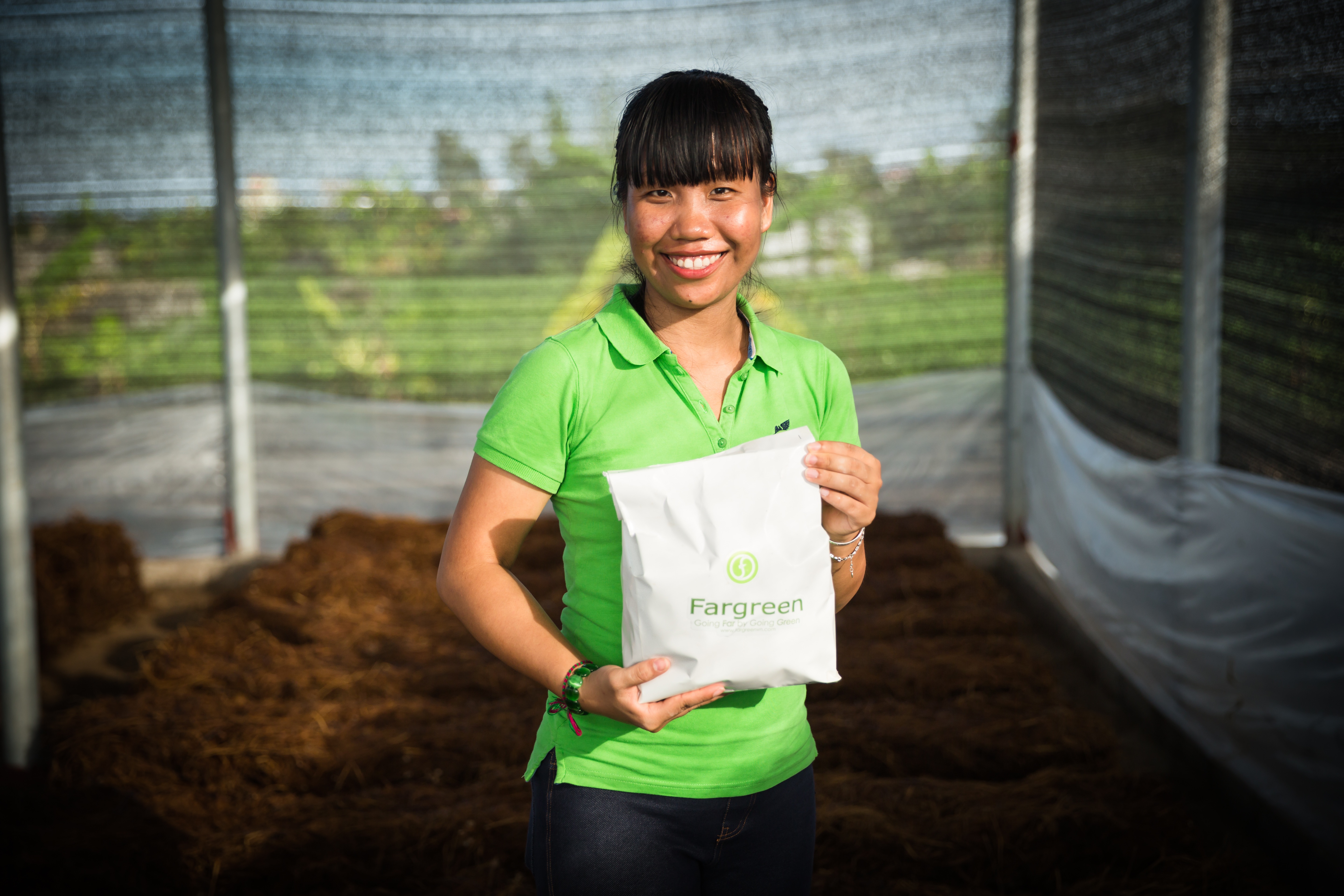
Social entrepreneur Trang Tran is teaching Vietnamese farmers how to use rice straw as a material in which to grow profitable mushrooms, helping to reduce greenhouse gas emissions and improve livelihoods. Photo: Fargreen
In agricultural entrepreneur Trang Tran’s native Vietnam, farmers traditionally burn the straw and husks that remain after the rice harvest. This practice happens at least twice a year for two months at a time, releasing noxious smoke and greenhouse gases into the atmosphere. Tran’s solution: using rice straw to cultivate mushrooms. Her social enterprise Fargreen is standardizing the process and teaching farmers how to recycle their own agricultural waste and improve their livelihoods. We asked Tran to tell us about how the idea evolved.
How did you become interested in the burning of rice straw as an environmental problem? Did you come from a farming community?
I’m from a little province called Hà Nam, two hours south of Hanoi, the capital city. My parents are not farmers, but Vietnam is an agricultural country, so everyone is surrounded by rice farms. Even if you live in Hanoi, the nearest farm is only a half an hour away.
Rice straw burning is something that happens every harvest season, and it happens all around us. It’s been done for many years, and it’s considered the most convenient way of getting rid of waste. Straw is perceived as having no value — farmers just want to get it out of the way as soon as possible in order to prepare for the next crop. In Vietnam, 20 to 50 million tons of rice straw are burned annually, releasing greenhouse gases into the atmosphere. Obviously this contributes to climate change, but the more immediate problem is that local people inhale the matter, causing serious health problems in communities — particularly in babies. Poor communities are most affected, and of course they have the least money for health care.
When rice straw is being burned, it’s very smoggy, and it’s hard to breathe. It also blocks visibility. A lot of car accidents happen during harvest season. It’s crazy — whenever I have to travel from my home to Hanoi for work, or come home during harvest season, rice straw is being burned along both sides of the road and it is very dangerous for drivers.
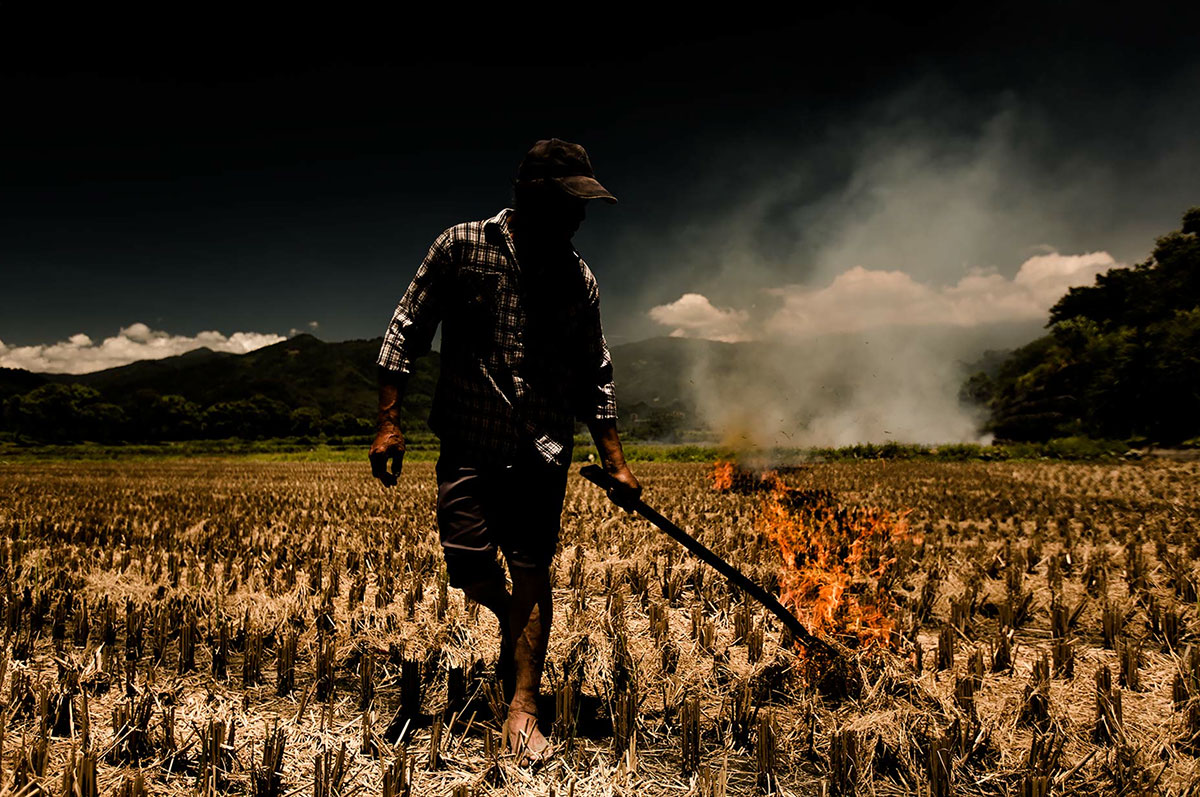
In rice-producing countries, rice straw is often burned on the field in preparation for new crops. Photo: Scott Gable
Why is straw burned on roads? Why not just on the field?
The part of the rice plant left in the ground after the harvest is burnt right on the field. But the part left over after threshing is piled by the side of the road. There isn’t much space to store the agricultural waste once it’s been threshed, especially in Northern Vietnam, and roadsides are typically far enough away from houses that the straw can be safely burned. Some people also believe burning straw on the field helps the soil, but it’s actually really damaging because the soil gets drier and drier, and it just gets harder to farm it every year. The straw can’t just be buried because there is too much of it; composting rice straw requires a special technique and takes time. There’s a real need for the farmers to clear the field for the next round of rice cultivation — we plant two crops in Northern Vietnam and three in Southern Vietnam.
How did you come up with the idea to use rice straw to grow mushrooms?
My background is in international development. When I went to get my MBA in Colorado State, I kept thinking about this problem of rice straw waste back home. I had always seen this as an environmental problem, but getting my MBA gave me a way to see the problem differently and find a new way to approach it. My friend Thuy Dao, who was a fellow undergraduate back in Vietnam but in the biotechnology department, shared my fascination. Once I joked with her, “Oh, maybe someday we’ll work together on this problem.” Later, when I was talking to people to find a collaborator, her name popped into my head. So I contacted her and we started doing research.
Of course, we were not the first to tackle this problem. We looked into the various ways other researchers have considered to deal with rice straw. But because we grew up in the community as well as working in development, we could see from the local perspective that the problem is far more complex than just the act of burning. You have to ask, “What is the motivation for farmers? What’s in it for them not to burn?” If there’s nothing in it for them, and burning saves time so they can prepare for their next crop, then you can’t blame them for wanting to continue.
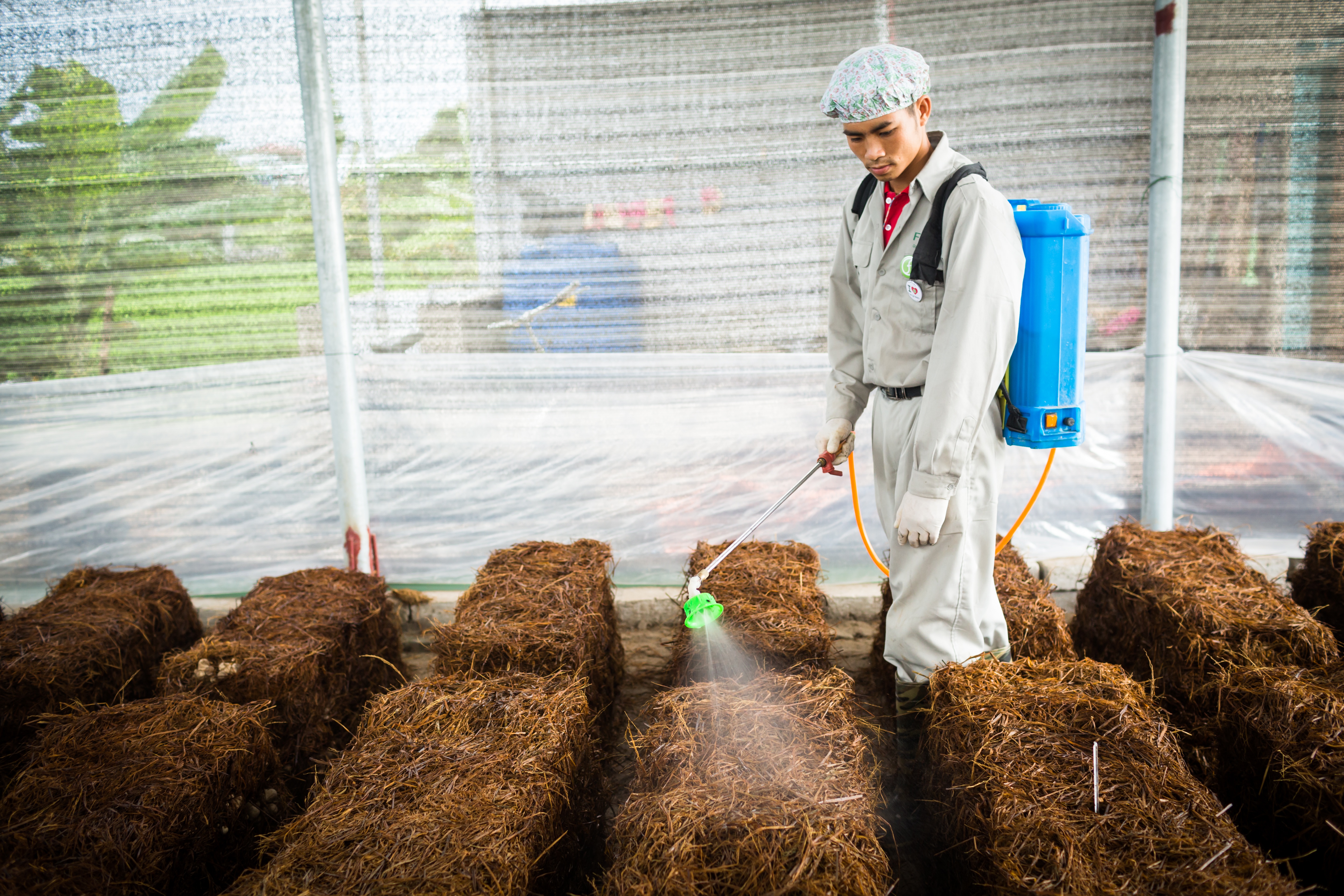
Bales of recycled rice straw are prepared for cultivating mushrooms. Photo: Fargreen
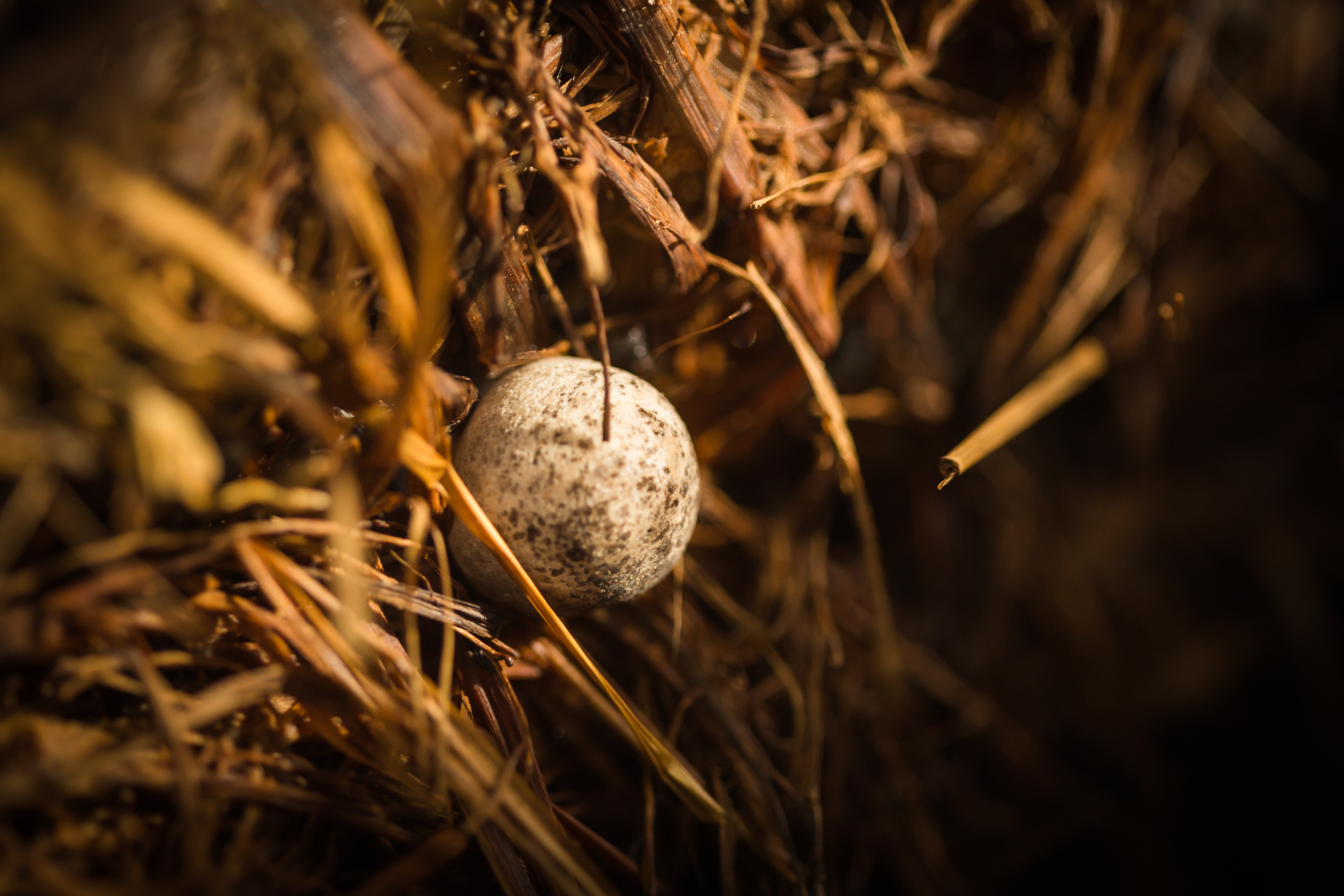
Fargreen grows white button, straw and oyster mushrooms. Photo: Fargreen
So we tried to think a bit differently — what can we offer the farmers that would make it worth it for them not to burn? In between rice seasons, most of the farmers we work with — many of them women — have to travel to the city to find employment. They don’t have skills to compete in the job market, so all they can get in cities are low-level jobs — picking up trash for recycling and so on. If they can stay on their land and cultivate a profitable crop between rice seasons, it would alleviate a lot of hardship.
One day, we discovered in our research that rice straw can be used to grow mushrooms. We saw that it wasn’t very complex, so we bought some spawn, collected some straw to the back of the house and grew a crop.
What were the varieties of mushrooms that you grew?
We grew paddy straw, oysters and white button. Our first harvest was only a few kilograms, but they were so good! At first we hadn’t even realized that the used straw could then be recycled back to the field. But we saw that the straw had turned into really good compost, because the fungi had helped break it down. Nearby farmers said, “Well, if you want to get rid of it, we’d love to get that to the field for you.” We said OK. We also started to experiment with planting potatoes with the used straw — you put the potatoes in soil, and layer the straw over it to provide more nutrients. We got a really good crop.
How did this experiment turn into an enterprise?
I went back to the United States to work on the business model, and thought about the impact we wanted to make and the sustainability of the business. We came up with a satellite business model. If we could get the farmers to grow the mushrooms while we retained control of the quality of the crops, we knew there would be a good market for them. Right now in Vietnam, 80 to 90 percent of mushrooms consumed come from China, but Vietnamese people distrust Chinese produce, worrying about the possibility of contamination by pollutants, chemicals, and so on.
So we thought, if we are completely transparent in how we produce our mushrooms, that would add value. It would mean an opportunity for farmers to increase their income as well. We’re targeting supermarkets and high-end restaurants whose consumers are highly conscious about food safety and quality. Right now, we work with a small group of farmers. Our target is, in seven years, to have hundreds of farmers in our network. When that happens, there’ll be a lot of mushrooms, which we might also be able to export. We’re also experimenting with drying and salting methods.
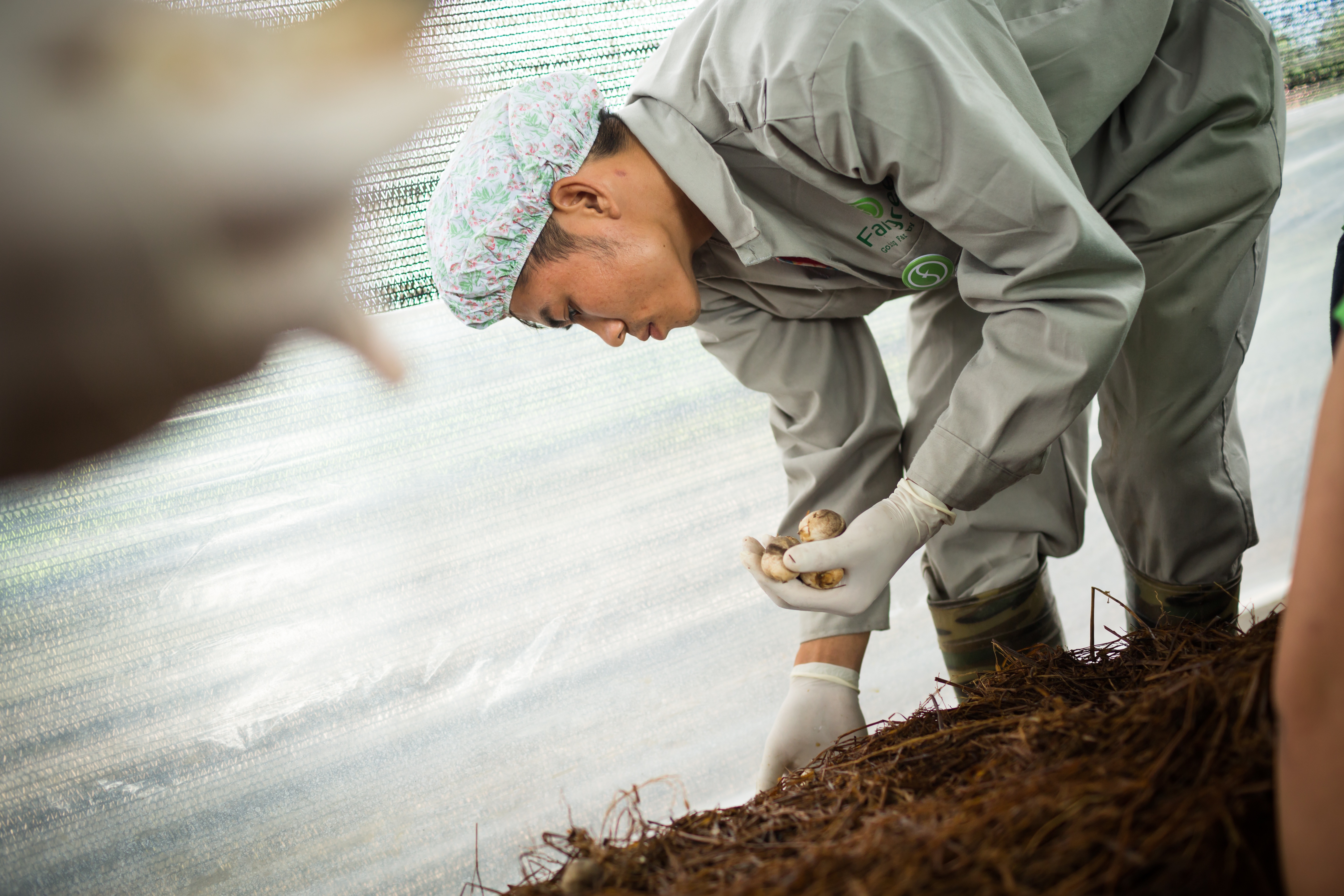
A Fargreen farmer harvests mushrooms. Photo: Fargreen
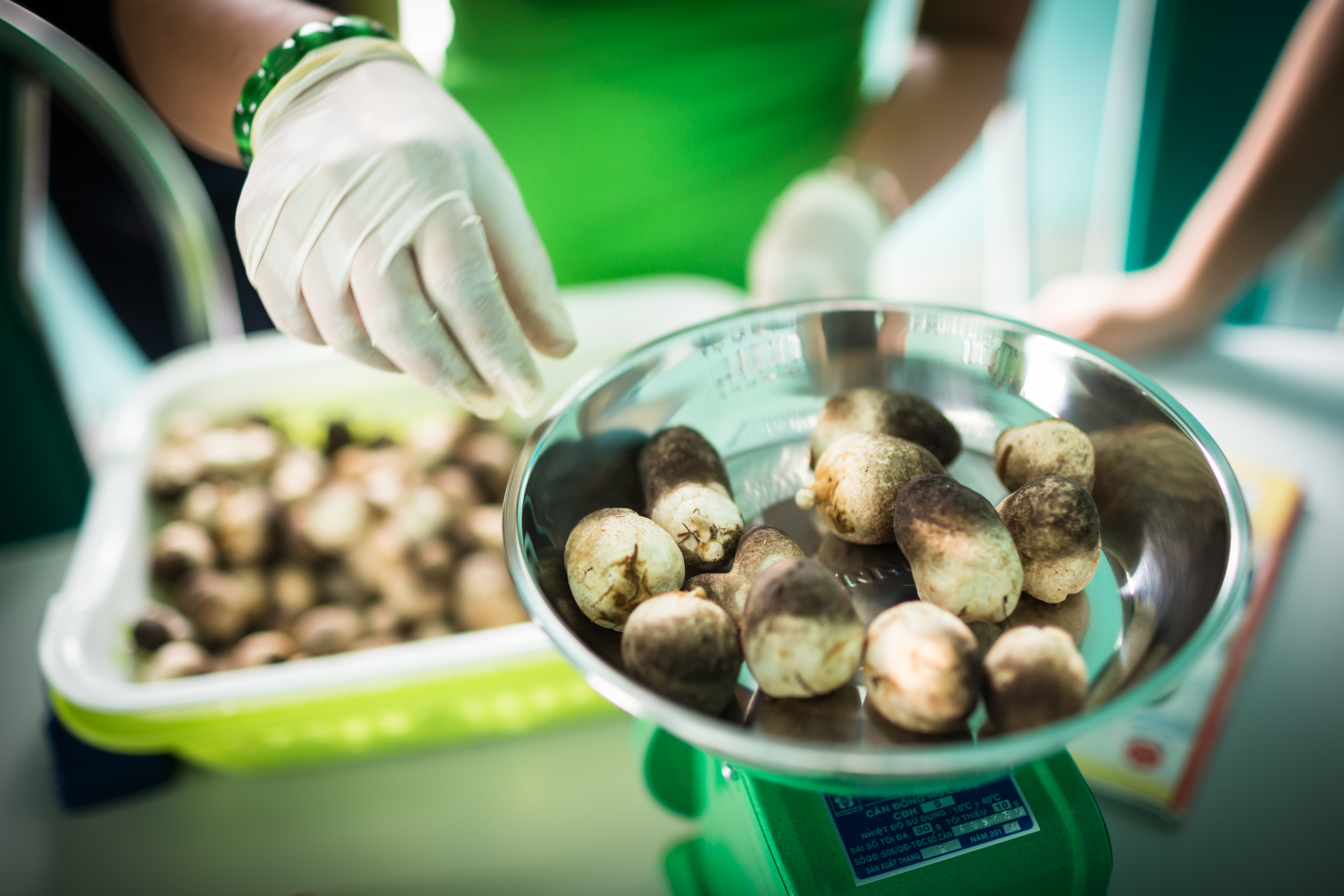
Mushrooms grown on rice straw are sorted and weighed before being sold to restaurants and grocery stores. Being able to stay home to cultivate profitable mushrooms between rice seasons prevents farmers from traveling to the city to find work. Photo: Fargreen
Is there an existing mushroom cultivation industry in Vietnam?
There is. The majority of the companies producing mushrooms right now use sawdust and cotton as their substrate. We’ll be the first company focusing on using straw to produce mushrooms. We could gather the straw and sell it to mushroom companies that are already in business, but that’s a different business model. We could even open a factory and grow the mushrooms ourselves. But how would we scale up? With this model, we can scale up anywhere. The mushrooms are grown by the farmers themselves, and all we need is a collection center where all the farmers can come and sell the mushrooms.
Regarding contamination, is there a possibility that Vietnamese rice straw itself contains pesticides or fertilizer residues?
You can’t totally avoid pesticides. But we do select which straw to use for our mushroom cultivation, avoiding fields that have been sprayed heavily with pesticides. We are also working on methods to analyze the residue in the straw so we’ll have a more precise indicator. After being collected, the straw gets dried and treated using a natural pasteurization method before it it’s used as a substrate for mushrooms. The process kills unwanted fungi or bacteria and softens the straw. It’s labor-intensive, as it’s done all by hand.
What kind of conditions are needed to grow mushrooms?
It depends on the mushroom that you grow. In general, mushrooms are quite sensitive to their environment, so beside keeping the environment clean to keep mushrooms from being attacked by unwanted fungi, we need to provide them with the right amount of moisture, temperature and sunlight to grow. For example, straw mushrooms like high temperatures and humidity, whereas oyster mushrooms prefer a cooler environment.
We have varied weather, so right now we grow seasonally. But we’re actually looking at building a mushroom house where we can help the fungi thrive in different temperatures and weather conditions, because weather’s changing right now. Vietnam is one of the countries that’s most affected by climate change.
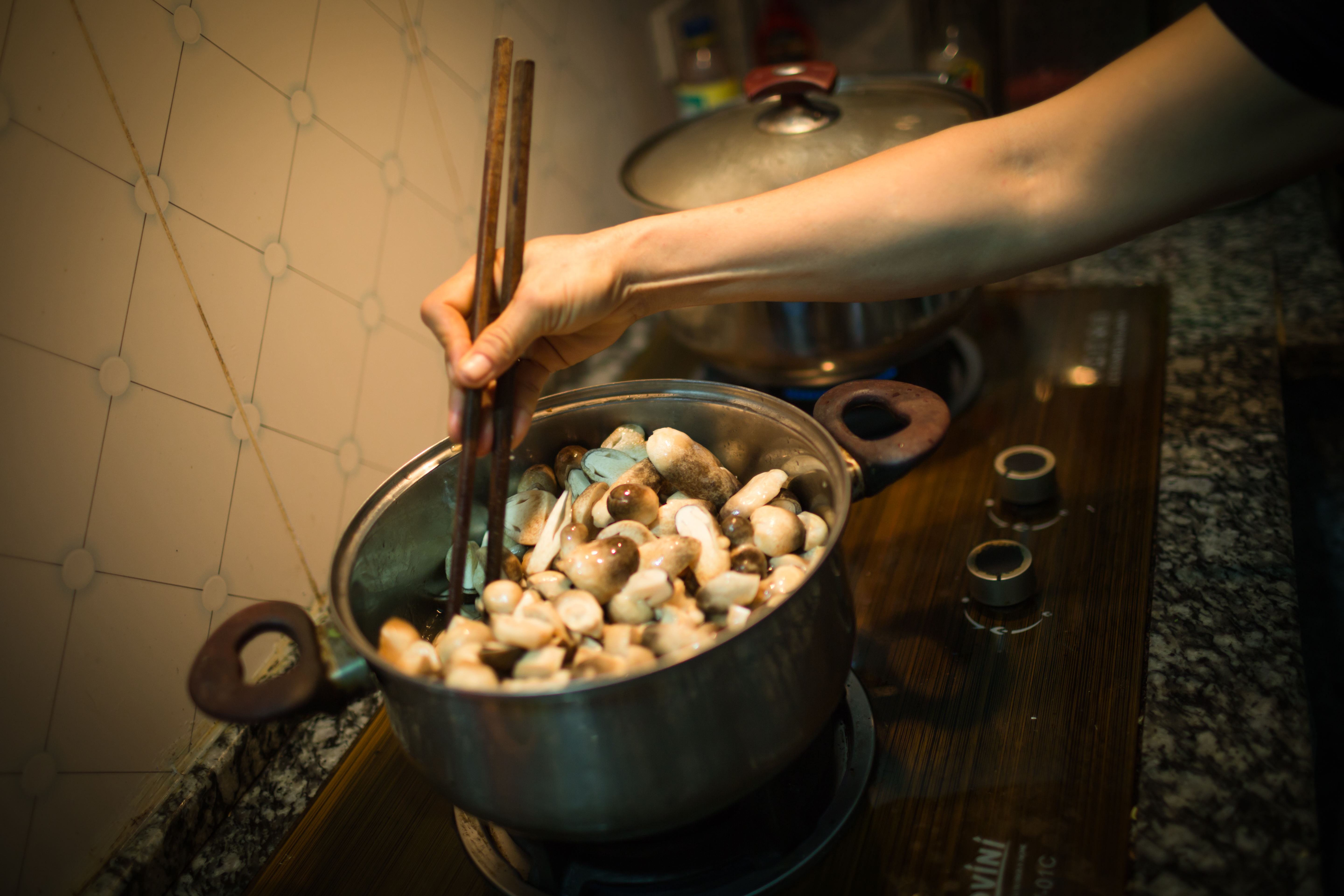
Tran hopes that Fargreen will produce enough mushrooms not only to supply the Vietnamese market, but to export dried and salted mushrooms within seven years. Photo: Fargreen
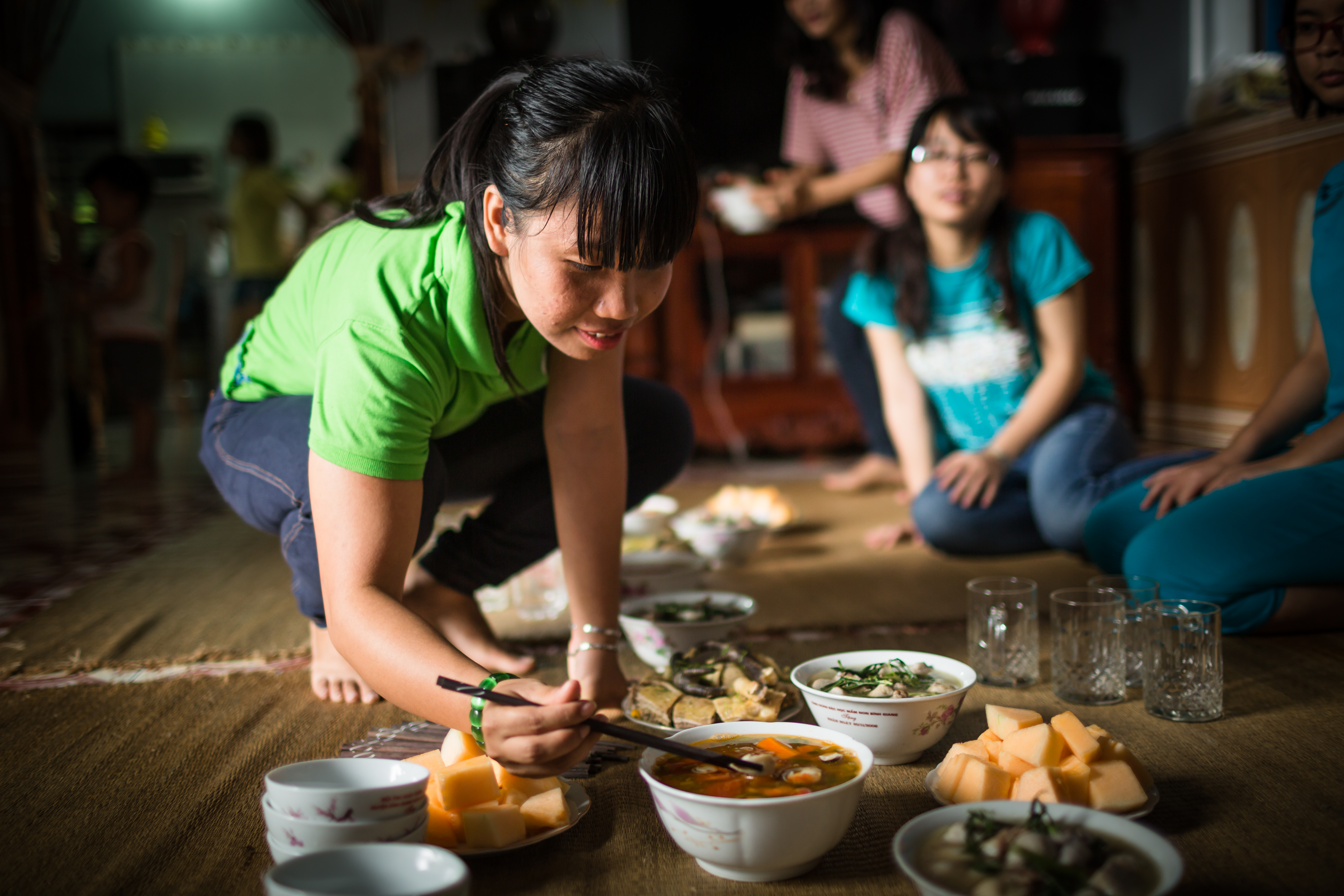
A feast of fungi. Photo: Fargreen
Realistically, can mushroom cultivation take care of the rice straw problem in Vietnam? Can each farmer get rid of all of his rice straw growing mushrooms?
I think it’s possible, yes. We have a very flexible model where right now most of the straw can be used for mushroom cultivation, and the used straw can be mixed with additional straw waste after mushroom cultivation to quickly create useful compost. Each farmer has, on average, a four-acre farm, so they only produce a few tons of straw per year. Fargreen’s few farmers have so far collectively saved 10 tons of straw from being burned – which is the equivalent of 10 tons of greenhouse gases.
What motivates you to do this work?
I grew up naturally aware of environmental conditions and how they affect life. My parents used to sell fresh homemade food in the local market, and because we didn’t have a fridge back then, my mom had to pay very close attention to the weather forecast to plan the amount of food they would prepare to take to the market. If it was a rainy day, nobody would want to stop by their kiosk in the market to buy their food, and that meant we’d have to throw the leftovers away.
There’s also a big river running behind the back of my home in Ha Nam. It used to be such a beautiful sweet river, and my dad used to carry me on his back across it in summers, when I was small. But as I grew up, I observed how the weather patterns in my country have changed over time. There are a lot of unexpected storms, floods and droughts — and that has changed the river.
But the main thing is that I want to improve the lives of Vietnamese farmers in a sustainable way. As I traveled doing development work, I noticed that the poor people were the ones who — like my parents in the old days — suffered the most from changes in weather patterns. Ours is a very agricultural country. Yet people in the farming industry are among the poorest. So to take Vietnam to the next level, we have to focus on our farmers.
Any plans to take Fargreen to other rice-producing countries?
Yes. As soon as we validate Fargreen in Vietnam and build the brand, we would love to franchise in other countries, because our neighbors are struggling with this problem, too. We think it will be a very attractive opportunity for farmers who want to diversify their income, and we hope to get environmentalists on board, too.
We hope that one day, we can also focus on making biofertilizer out of the straw waste after mushroom cultivation, which will help create organic farmers. So there will be more after mushrooms. For me, the goal is to prove that businesses can do well by doing good, that you can build prosperous and sustainable farming communities, prioritize the environment and still create a successful enterprise. That’s why we called it Fargreen — going far by going green.
Comments (12)